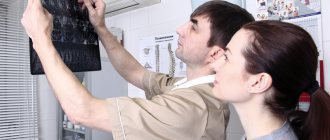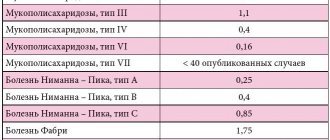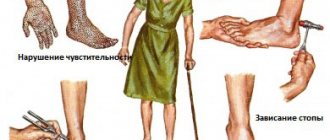Polyneuropathy, or peripheral neuropathy, occurs as a result of damage to the peripheral nerves and often results in symptoms such as weakness, numbness and pain, usually in the arms and legs. But polyneuropathy can also affect other areas of the body. Peripheral neuropathy may develop in one nerve (mononeuropathy), two or more nerves in different areas, or may involve many nerves (polyneuropathy).
The peripheral nervous system transmits information from the brain and spinal cord (central nervous system) to the rest of the body. Peripheral neuropathy can result from traumatic injuries, infections, metabolic disorders, hereditary causes, and exposure to toxins. One of the most common causes of polyneuropathy is diabetes mellitus.
Patients with peripheral neuropathy typically describe pain as a tingling or burning sensation. In many cases, symptoms decrease if compensation occurs for the underlying disease.
Each nerve in the peripheral nervous system has a specific function, so symptoms depend on the type of nerve that is damaged. Nerves are divided into:
- Sensory nerves that receive sensations from the skin, such as temperature, pain, vibration, or pressure
- Motor (motor) nerves that control muscle movement
- Autonomic nerves that control functions such as blood pressure, heart rate, digestion, and bladder function
Information about polyneuropathy
The word "polyneuropathy" is translated from Greek as "damage to many nerves." This term very accurately describes the essence of the pathology. All structures of the body are entangled in a network of thin nerve fibers, which are divided into three groups:
- motor: responsible for motor functions;
- sensory: provide tissue sensitivity;
- Autonomous (vegetative): necessary for the unconscious regulation of the activity of certain structures, for example, blood vessels or internal organs.
Damage to certain fibers inevitably leads to disruption of their functions. The most common is mixed polyneuropathy of the lower extremities, in which symptoms of dysfunction of the sensory and motor nerves appear.
Make an appointment
Causes
Damage to peripheral nerves can occur due to the following conditions:
- diabetes mellitus: the most common cause of polyneuropathy, resulting from metabolic disorders in the myelin sheath of nerve fibers; mainly the lower extremities are affected;
- severe and prolonged deficiency of B vitamins necessary for the full functioning of the nervous system;
- infectious diseases: HIV, tick-borne borelliosis, leprosy;
- renal failure;
- alcohol abuse;
- acute and chronic intoxication, including drugs;
- autoimmune diseases: damage occurs against the background of a malfunction of the immune system; the most common are chronic and acute inflammatory polyneuropathy (Guillain-Barré syndrome);
- long stay in intensive care, for example, with extensive injuries or serious illness;
- exposure to ionizing radiation;
- pregnancy: carrying a child can cause vitamin deficiency and autoimmune lesions.
In addition, there are hereditary forms of the disease, transmitted from relatives, as well as idiopathic polyneuropathy, the cause of which cannot be determined.
Possibilities of using B vitamins for COVID-19
With increasing knowledge of the therapeutic potential of thiamine, pyridoxine, and cyanocobalamin, B vitamins are being used for more than just neuroprotection [29, 30].
It is not surprising that researchers are interested in their use in complex therapy and rehabilitation of patients with new coronavirus infection (COVID-19), which is especially important for patients with risk factors for severe COVID-19 (age over 60 years, obesity, carbohydrate metabolism disorders, arterial hypertension, heart failure, chronic obstructive pulmonary disease) [31].
Interest in the use of B vitamins is justified by the frequent damage to various parts of the nervous system in patients with COVID-19 and a wide range of neurological manifestations that reduce the quality of life, as well as the neurotoxic side effects of a number of drugs used to treat COVID-19 (lopinavir, ritonavir, hydroxychloroquine, linezolid, clindamycin and glucocorticoids) [29, 30, 32].
While continuing to cause enormous damage to global health, COVID-19 is creating a global public health emergency, with efforts to find effective prevention and treatment measures unprecedented in recent history [33]. Modern studies have shown that a number of medications, vitamins (melatonin, B vitamins, vitamins D, C, etc.), having immunomodulatory mechanisms of action, have some potential for treating patients with COVID-19 [30, 34, 35]. In addition, the deficiency of certain substances in various population groups is associated with a decrease in the functional abilities of the immune system and an increase in susceptibility to viral infections, which also increases the likelihood of severe COVID-19 and requires new clinical solutions [34–36].
In particular, the antiviral effects of B vitamins are being actively studied and analyzed, taking into account the potential impact on the replication of the SARS-CoV-2 coronavirus [30].
In a recently published study by N. Narayanan et al. [36] revealed the inhibitory effect of vitamin B12 on the RNA polymerase activity of the viral protein nsp12, which is important for the replication of the SARS-CoV-2 virus. The authors suggest that inhibition of the nsp12 protein may lead to a decrease in viral titer and severity of COVID-19 disease. Of course, further research in this direction is required.
Thiamine deficiency is associated with decreased functional ability of the immune system and increased susceptibility to viral infections. The ability of thiamine to reduce elevated levels of pro-inflammatory interleukin (IL)-17, suppress the pro-inflammatory response of macrophages and increase the concentration of anti-inflammatory IL-22 is of interest as an effective and safe measure to prevent the “cytokine storm” in COVID-19 [37]. Vitamin B1 has not only anti-inflammatory but also antithrombotic effects [23, 38]. A good illustration of this is the study by K. Al Sulaiman et al. [39] included 166 patients who were admitted to intensive care units, 83 of whom received thiamine as adjunctive therapy. A significant association was found between thiamine use and in-hospital mortality (odds ratio (OR) 0.39; 95% confidence interval (CI) 0.19–0.78; p=0.008), as well as 30-day mortality (OR 0.37 ; 95% CI 0.18–0.78; p=0.009). Moreover, patients receiving thiamine as adjunctive therapy (mean dose 100 mg/day, duration 7 days) were less likely to develop thrombosis during their ICU stay (OR 0.19; 95% CI 0. 04–0.88; p=0.03). Therefore, the use of thiamine as an adjunctive therapy may have potential survival benefits in critically ill patients with COVID-19. In addition, it was associated with a lower incidence of thrombosis in patients receiving thiamine as adjunctive therapy [39].
The discovered effect of vitamin B6 also attracts attention - participation in the regulation of the homeostasis of imidazole dipeptides (carnosine and anserine), which are cardioprotectors with antioxidant and anti-inflammatory properties; according to T. Kumrungsee et al. [35], vitamin B6 supplementation may be beneficial for COVID-19 patients with vitamin B6 deficiency.
A marker of active infection, the severity of the process and an unfavorable prognosis of COVID-19, along with an increase in the level of C-reactive protein, D-dimer, fibrinogen, is recognized as an increase in the concentration of homocysteine - a risk factor for microcirculatory and thrombotic complications against the background of various diseases. In the presence of high homocysteine levels, the coagulant balance is disrupted and damage to vascular tissue occurs [30, 40]. The relationship between hyperhomocysteinemia and cardiovascular diseases is due to a number of pathological mechanisms caused by increased homocysteine levels: dysfunction of the endothelium, activation of oxidative stress, vascular inflammation, stimulation of proliferation of vascular smooth muscle cells, activation of blood coagulation factors (XII factor, V factor and tissue factor), platelet hyperaggregation against the background of increased levels of the platelet aggregation agonist and vasoconstrictor thromboxane A2 [41–43]. The metabolism of homocysteine occurs with the active participation of vitamins B6, B12, folates, acting as cofactors or enzyme substrates (Fig. 2) [41, 44], therefore vitamin deficiency states are common causes of hyperhomocysteinemia [45].
It is clear that any safe and effective measures to limit the adverse effects of COVID-19 on the human body are vital. Of interest are the results of the study by BC Procter et al. [46], who showed that when B vitamins were included in the complex pharmacotherapy of COVID-19 at the outpatient stage, a decrease in hospitalization and mortality of patients was noted.
In a study by CW Tan et al. [47] with the additional use of vitamin B12 (500 mcg/day), vitamin D (1000 IU/day) and magnesium (150 mg/day) in patients over 50 years of age, a decrease in the risk of COVID-19 transition from moderate to severe form of the disease was noted . Vitamins and magnesium were prescribed to persons who did not require oxygen therapy at the time of admission to the hospital. Without taking these vitamins and magnesium, the need for oxygen therapy during hospitalization arose in 61.5% of cases, and with their use - in 17.6% (OR 0.13; 95% CI 0.03–0.59; p= 0.006).
We cannot ignore the fact that in patients with diabetes who have had COVID-19, the risk of worsening the course of DN increases [48, 49]. In turn, DN and diabetic autonomic neuropathy contribute to impaired immune responses in response to viral infections [50].
The effect of B vitamins on the metabolism of neurotransmitters (acetylcholine, dopamine, serotonin and γ-aminobutyric acid), restoration of myelin sheaths of nerves, and anti-inflammatory effects allow us to consider them as promising agents for the treatment of neurological manifestations of COVID-19, including at the stage of rehabilitation measures [ 51]. In addition, vitamin B12 helps overcome anosmia, one of the earliest and most frequently reported symptoms of COVID-19, which affects the quality of life of patients [52].
Currently, B vitamins are not included in the Temporary Guidelines of the Ministry of Health of the Russian Federation for the prevention, diagnosis and treatment of new coronavirus infection; further research in this area of medicine is required [50]. However, given the ongoing threat of the spread of a new coronavirus infection, its extremely unfavorable consequences for humanity, as practical experience in managing patients with COVID-19 accumulates, and evidence emerges of the effectiveness of new therapeutic options to improve the outcomes of this unpredictable disease, patient management protocols are constantly updated. The first positive results regarding clinical outcomes, based on a decrease in mortality, are accumulating when thiamine is included in a comprehensive protocol for the management of hospitalized patients with COVID-19, which became the basis for discussing the possibility of its inclusion in the list of potential interventions for a new coronavirus infection [39, 54, 55 ]. In particular, thiamine is one of the components of the MATH+ protocol for inpatient management of patients with COVID-19, which makes it possible to implement in practice a highly effective combination treatment aimed at eliminating a strong inflammatory reaction, which is based on methylprednisolone [55].
Kinds
Polyneuropathy is divided into several types depending on the type of fibers affected:
- sensory: the nerves that provide sensitivity are affected;
- motor: disturbances in the functioning of motor nerves are detected;
- motor-sensory: mixed form, in which motor disorders predominate;
- sensory-motor: mixed neuropathy, in which sensitivity disturbances are more pronounced;
- vegetative: first place comes to disturbances in the functioning of internal organs, changes in vascular tone and associated trophic disorders.
Significant differences in symptoms are noticeable only in the initial stages of the disease. Subsequently, all nerve fibers are involved in the pathological process, and the manifestations become mixed.
There are other types of classification of the disease:
- depending on the cause: alcoholic, diabetic, idiopathic, etc.;
- depending on the location of the lesion: polyneuropathy of the upper or lower extremities;
- depending on the type of course: acute, subacute, chronic;
- depending on the mechanism of occurrence: demyelinating (the sheath covering the nerve fibers is destroyed), axonal (formed by the death of nerve processes - axons), axonal-demyelinating.
What is diabetic neuropathy
Diabetic neuropathy
is a combination of syndromes affecting various parts of the peripheral and autonomic nervous system, which occurs against the background of metabolic disorders in diabetes mellitus and complicates its course.
According to statistics, being one of the most common and serious complications of diabetes, various forms of diabetic neuropathy are diagnosed in almost half of all patients with diabetes.
Diabetic neuropathy is characterized by signs of impaired conduction of nerve impulses, sensitivity, as well as various disorders of the somatic and autonomic nervous systems that arose when other causes and factors of nervous system dysfunction (trauma, infections, etc.) were excluded. The clinical manifestations of the disease are very diverse, so most doctors with a narrow specialization encounter diabetic neuropathy - neurologists, urologists, endocrinologists, gastroenterologists, dermatologists, etc.
Symptoms
Symptoms of polyneuropathy depend on its cause and the characteristics of the damage to the fibers. The most common signs of pathology include:
- decreased sensitivity of the feet and palms, leading to the subjective sensation of wearing socks or gloves;
- pain in the affected limbs (sharp or dull, short-term or nagging, usually worse at rest and at night);
- spasms and twitching of muscle fibers;
- pain when touching the skin or pressing on the affected limb;
- decreased reflexes;
- increased sweating of the extremities;
- trophic disorders: swelling, changes in skin color and dryness, trophic ulcers;
- weakness of the muscles of the arms and legs, slight tremors;
- paresthesia: pathological sensations of crawling, burning, coldness;
- muscle atrophy;
- restless legs syndrome.
Alcoholic polyneuropathy
This form of the disease most often affects the lower extremities. It develops with prolonged uncontrolled consumption of alcoholic beverages and manifests itself primarily as a burning sensation and tingling sensation in the legs. With the further development of the pathology, the patient begins to feel numbness and muscle cramps, which develop due to the concomitant lack of B vitamins.
Diabetic polyneuropathy
Elevated sugar levels cause damage to the nerves of the feet (distal version) and the upper legs (proximal version). In the first case, a person experiences a characteristic set of symptoms:
- numbness and decreased pain sensitivity;
- periodic burning pain;
- muscle weakness;
- decreased reflexes;
- impaired coordination of movements, manifested by unsteadiness of gait.
The combination of polyneuropathy with damage to small vessels leads to the appearance of trophic ulcers in the lower part of the leg. The proximal version of the lesion is characterized by sharp pain in the buttock and upper thigh, as well as gradual muscle atrophy in this area.
Statistics
Polyneuropathy is the most common complication of diabetes mellitus, developing in patients with type I diabetes in 54% of cases, in patients with type II diabetes in 45% of cases. In the general structure of polyneuropathies, the diabetic variant occupies 30%.
Diabetic polyneuropathy is detected in 10% of patients who are first diagnosed with diabetes mellitus (we are talking about type II).
An asymptomatic form is often found, so almost 50% of patients diagnosed with diabetes mellitus do not report symptoms of polyneuropathy, which is detected only during instrumental studies or routine medical examinations.
Diabetic polyneuropathy in 20% of cases is manifested by severe pain, which is recognized as one of the most painful types of pain. It is the diabetic variant of polyneuropathy that is the indirect (indirect) cause of more than 50% of cases of non-traumatic amputations.
Diagnostics
Diagnosis of polyneuropathy requires a comprehensive examination, which includes:
- survey: identifying patient complaints, clarifying the time and circumstances of the occurrence of each symptom;
- taking an anamnesis: recording all past diseases, injuries, intoxications, chronic pathologies, hereditary risk factors, etc.;
- neurological examination: assessment of skin and proprioceptive (spatial) sensitivity, motor function, muscle strength, quality of reflexes;
- consultations with specialized specialists: endocrinologist, narcologist, toxicologist, nephrologist, etc.;
- general urine test, general blood test, blood biochemistry (determination of glucose levels, lipid spectrum, vitamins and microelements, kidney function indicators and other parameters);
- blood test for HIV and other infections;
- genetic and immunological studies according to indications;
- Electroneuromyography allows you to identify lesions of nerve fibers and exclude other diseases with similar symptoms;
- biopsy of nerve and muscle tissue;
- lumbar puncture (examination of cerebrospinal fluid) to exclude neuroinfections;
- Doppler ultrasound of the vessels of the lower extremities.
The list of examinations can be adjusted depending on the form of polyneuropathy and concomitant pathology.
What other type of diabetic polyneuropathy is there?
Distal diabetic polyneuropathy is a common complication of diabetes mellitus. It is believed that more than a quarter of patients suffer from a clinically pronounced form of diabetic polyneuropathy, and in an asymptomatic form, which is detected only by electromyography, the disease is present in all patients with diabetes.
The main reason for the development of distal polyneuropathy in diabetes mellitus is a prolonged increase in plasma glucose levels. Therefore, the only effective way to slow the progression of diabetic polyneuropathy is careful monitoring of blood sugar levels and adequate insulin therapy or treatment with sulfonylurea drugs, which is effective for patients with non-insulin-dependent diabetes.
What it is
Symmetric sensorimotor distal polyneuropathy, also called diabetic polyneuropathy, is the most common clinical manifestation of nervous system disease.
Diabetic distal sensory polyneuropathy of the lower extremities is characterized by damage to a number of nerve fibers that are responsible for the motor and sensory functions of the foot:
- pain;
- temperature;
- tactile.
The main signs that allow a patient to be classified as at risk for developing distal diabetic polyneuropathy are:
- duration of diabetes mellitus more than 5 years;
- complications on the capillaries of the retina;
- excess body weight;
- hypertension;
- ischemic heart disease;
- hereditary predisposition to diabetic polyneuropathy;
- increased levels of cholesterol, lipoproteins in the blood and albumin in the urine.
The incidence of the disease is not affected by the type of diabetes mellitus.
The peripheral nervous system is divided into somatic and autonomic. Accordingly, the clinical picture of the disease may be different. Autonomic polyneuropathy is the most dangerous for human life; often in advanced stages it leads to problems with urination, potency, functions of the heart and blood vessels, and death.
When the somatic nervous system is damaged, trophic ulcers appear on the skin of the lower extremities. There is another type of disease - mixed or sensorimotor. In this case, the peroneal nerve is affected, and patients lose sensation in the feet and legs and lose the ability to control them.
Causes of diabetic distal polyneuropathy
Diabetic distal polyneuropathy refers to metabolic disorders of the nervous system. Vascular factors are of particular importance in the development of complications:
- insufficient blood supply to nerve endings due to vascular damage;
- thrombosis;
- microangiopathy.
Factors that increase the likelihood of developing the disease include:
- long-term diabetes mellitus;
- the patient's age is over 50 years;
- hyperglycemia;
- hyperlipidemia;
- arterial hypertension;
- regular consumption of alcoholic beverages;
- obesity;
- smoking.
The longer high blood sugar levels remain, the greater the likelihood of developing distal diabetic polyneuropathy and the more severe its course.
Additional risk factors include smoking. Since the heart rate increases, tobacco smoke has a detrimental effect on the condition of the body as a whole.
The disease is primarily differentiated from polyneuropathy, which is caused by other reasons:
- infections that have entered the body;
- toxic poisoning;
- alcoholism;
- diseases of the thyroid gland;
- long-term vitamin deficiency;
- oncological diseases;
- pathologies of the autoimmune system.
It is worth remembering that distal polyneuropathy, which developed against the background of diabetes, is not in all cases its consequence
The first signs of diabetic distal polyneuropathy
In the subclinical, that is, at the earliest stage, the disease does not bother the victim at all. However, during a neurological examination, an experienced doctor will identify the following signs of a primary lesion:
- decreased tactile sensitivity of the skin of the foot;
- violation of deep tendon reflexes.
As the disease develops, the clinical phase begins, which is accompanied by external manifestations. The first signs of the early stage include:
- decreased sensitivity of the skin of the feet to temperature;
- crawling sensation;
- tingling;
- burning;
- increased sensitivity to minor touches;
- convulsions;
- pain syndrome of varying intensity and nature.
Victims often experience a completely paradoxical reaction: on the one hand, there is no sensitivity to external influences, and on the other, there are pains that are in no way related to external stimuli.
Diabetic distal polyneuropathy: main symptoms
The main symptoms of the disease begin to appear when the pathological process has led to irreversible changes in the body. Damage to nerve fibers is accompanied by the following symptoms:
- depletion of the skin;
- dry skin of the feet;
- atrophy of muscle tissue;
- the appearance of a growth in the area of the thumb joint;
- impaired coordination;
- paresis;
- unsteady gait.
In diabetic distal polyneuropathy, both feet are involved in the pathological process. More than half of patients have an asymptomatic form of the disease. In this case, the lesion is diagnosed only at the very last stage of complications - when trophic ulcers occur.
Diagnosis of diabetic distal polyneuropathy
If sensory diabetic polyneuropathy is suspected, the examination procedure and a set of diagnostic procedures are determined. The main areas of diagnostics are:
- examination by an endocrinologist;
- complete laboratory blood test;
- assessment of the state of the cardiovascular system using an echocardiogram or electrocardiogram;
- study of nervous reflexes;
- diagnosis of the gastrointestinal tract using ultrasound, radiography, esophagogastroduodenoscopy, etc.;
- examination of the urinary tract, that is, ultrasound, urography, urinalysis or cystoscopy.
If indicated, you may need to consult with specialized specialists, such as a cardiologist or dermatologist, as well as perform a tissue biopsy of the sural nerve or skin.
Often the disease is diagnosed based on the victim’s complaints. But even if a diabetic patient does not notice symptoms, this does not mean that the disease is absent. An experienced therapist knows that in more than half of cases the disease occurs without symptoms. That is why additional studies are prescribed to accurately assess the condition. Chronic polyneuropathy, which is asymptomatic, can be determined in two ways:
- electromyography;
- quantitative sensory testing.
Patients diagnosed with diabetes must undergo regular testing for diabetic polyneuropathy, at least once a year and even if there are no complaints.
Usually, a single research method is not effective because it cannot show the full picture, so several types of diagnostics are used at once:
- visual. Consists of examination by a therapist, neurologist, endocrinologist and surgeon. Specialists study the sensitivity of the skin, the presence of necessary reflexes, the condition of the skin, the level of blood pressure in the vessels of the lower extremities;
- instrumental. Includes nerve biopsy, electroneuromyography and magnetic resonance imaging;
- laboratory It is a whole set of studies: urine analysis, determination of sugar levels in the blood plasma, identification of cholesterol concentrations, determination of toxic substances in the body.
Many patients do not notice the progression of symptoms of the disease in the body, and therefore do not complain during examination.
Treatment of distal polyneuropathy
A prerequisite for effective treatment of diabetic distal polyneuropathy is the normalization of glucose levels in the victim’s body. It is for this purpose that specific therapy is prescribed, for example insulin, and constant monitoring of blood sugar levels.
By maintaining optimal sugar levels, degenerative changes in the nervous system can be slowed down or completely stopped. Early diagnosis of peripheral or autonomic diabetic polyneuropathy ensures a favorable prognosis during treatment. It is important to know that advanced diabetic distal neuropathy is one of the main risk factors in the development of arrhythmia, myocardial infarction or other life-threatening diseases.
There are several main areas of treatment for diabetic polyneuropathy:
- pathogenetic. Aimed at restoring the functions of nerve fibers;
- symptomatic. Necessary for stopping the manifestations of pathologies.
Such therapy cannot eliminate the root cause of the disease, but it is necessary to slow the progression of the disease, minimize the likelihood of complications, and improve the physical and emotional state of the victim.
Direct treatment of diabetic distal polyneuropathy is conservative and includes:
- drug therapy;
- physiotherapy;
- therapeutic exercises;
- diet;
- herbal medicine.
Treatment that includes multiple types of therapy provides better results. However, self-medication is unacceptable; you must first consult with your doctor. Most medications require careful dosage selection and competent compatibility assessment. A number of medications and techniques are contraindicated for diseases concomitant with diabetic polyneuropathy.
Treatment is carried out exclusively in long courses, since the effect does not appear immediately. To eliminate pain and accompanying sleep disorders, anxiety, and depression, the following groups of drugs are prescribed:
- antidepressants;
- anticonvulsants;
- drugs that relieve arrhythmia;
- painkillers.
Therapeutic exercises, physiotherapy and massage help relieve pain, nourish nerve and muscle tissue, prevent muscle atrophy, improve neuromuscular conduction, restore normal blood flow, and also increase range of motion. Various physiotherapy techniques have been developed, for example:
- magnetic wave therapy;
- ultraphonophoresis;
- electrophoresis;
- mud baths.
Massage can be used both classical and acupuncture. Its duration should be from 30 to 60 minutes. Smooth movements simultaneously relax and tone the muscles, normalizing blood microcirculation.
It is recommended to enrich the diet with vitamins and microelements that help improve neuromuscular conduction. These include:
- potassium;
- magnesium;
- B vitamins.
Sources of useful substances are foods such as:
- legumes, that is, lentils, peas, beans;
- buckwheat grain;
- sunflower seeds;
- bran;
- walnuts, almonds, cashews, peanuts;
- tomatoes;
- cucumbers;
- parsley;
- fish and other seafood.
If the disease is not accompanied by kidney damage, then you should not limit the consumption of animal proteins with meat, poultry or fish. Since a lack of protein only aggravates the process of muscle tissue degeneration.
In the case of long-term maintenance of glucose in the body at a certain level, therapy for polyneuropathy is most effective. This is especially true provided that treatment is started at an early stage, since it is in the initial phase that pathological changes are still completely reversible.
In rare cases, stable remission cannot be achieved even with normalization of sugar levels. Patients from this group and those who, for whatever reason, did not start complex treatment, very often develop serious complications, such as:
- diabetic foot;
- Charcot's foot.
In such cases, gangrene can often occur, which entails amputation of the affected area.
Prevention
Preventive measures that prevent the development and relapse of diabetic polyneuropathy of the distal sensory type:
- regular monitoring of plasma glucose levels;
- normalization of body weight;
- exclusion of smoking, drinking alcohol and narcotic substances.
A disease such as diabetic sensory distal polyneuropathy is a severe neurological complication of diabetes mellitus, which is accompanied by a serious deterioration in the patient’s standard of living and can often lead to disability if the patient does not receive qualified treatment.
Treatment of polyneuropathy of the extremities
Treatment is aimed at eliminating the main cause of damage to nerve fibers, restoring their normal functioning, as well as eliminating symptoms that are unpleasant for the patient.
Depending on the cause of the disease, the following may be prescribed:
- drugs to correct blood sugar levels;
- antihistamines;
- immunoglobulins and glucocorticosteroids to eliminate inflammation and autoimmune damage;
- plasmapheresis and detoxification drugs;
- antibiotics for infections.
To restore nerve fibers, the following are used:
- B vitamins (milgamma, neuromultivit);
- drugs that improve blood circulation, metabolism and tissue regeneration: actovigin, cerebrolysin, berlition (especially effective for diabetes mellitus);
- angioprotectors: trental, pentoxifylline;
- means to enhance the conduction of nerve impulses to muscles: neuromidin.
Symptomatic therapy includes:
- non-steroidal anti-inflammatory drugs (ibuprofen, diclofenac, ketorolac), glucocorticosteroids (hydrocortisone, dexamethasone), analgesics (analgin, lidocaine) in the form of tablets, injections or local forms to relieve pain;
- anticonvulsants: tebantin, catena;
- antidepressants for chronic pain;
- sleeping pills according to indications.
Non-drug therapy is of great importance in the treatment of polyneuropathy. It includes:
- restorative and therapeutic massage to stimulate blood circulation in tissues, their nutrition and regeneration, as well as strengthen muscles;
- electrophoresis and phonophoresis with analgesics, B vitamins and other drugs (the use of electric current or ultrasonic waves facilitates the delivery of drugs to the affected area);
- electrical stimulation of muscles;
- magnetic therapy, UHF therapy, ultraviolet irradiation;
- darsonvalization: exposure to high frequency alternating current to improve metabolism and tissue regeneration;
- mud therapy: mud applications on the affected area;
- therapeutic baths with mineral waters or sea salt;
- physical therapy: dosed physical activity strengthens muscles and improves blood circulation in them; at an advanced stage of the disease, it is necessary to start with the easiest complex and gradually complicate it.
- classical acupuncture and electroacupuncture: stimulate the work of muscle tissue and nerve fibers;
- classes with an occupational therapist: necessary when it is not possible to fully restore the function of the limb; exercises are aimed at developing new movements adapted to the capabilities of the arm or leg.
For full treatment, a long-term complex effect on the affected area is required. Only if the patient thoroughly fulfills all the doctor’s instructions can success be achieved, but even in this case, full restoration of the functions of the nerve fibers is not guaranteed.
Causes and mechanisms of development of diabetic neuropathy
The main cause of diabetic neuropathy is chronically elevated blood glucose levels.
, ultimately leading to changes in the structure and functioning of nerve cells.
Due to impaired carbohydrate metabolism in diabetes mellitus, patients develop microangiopathies
- pathological changes in the vessels of the microvasculature, due to which the normal blood supply to the nerves is disrupted. As a result of multiple metabolic disorders, swelling of the nervous tissue develops, all metabolic processes in the nerve fibers are disrupted, the conduction of nerve impulses deteriorates, the antioxidant system is inhibited, leading to the accumulation of free radicals that have a detrimental effect on nerve cells, the production of autoimmune complexes begins, which ultimately can lead to atrophy of nerve fibers.
There are a number of factors that increase the risk of developing diabetic neuropathy:
- old age;
- long history of diabetes mellitus;
— decompression phase;
- increased blood pressure;
- overweight and obesity;
- smoking, drinking alcoholic beverages.
Complications
If you do not consult a doctor in time and do not eliminate the cause that caused the damage to the nerve fibers, neuropathy will steadily progress. Complications of the disease include:
- a significant decrease in muscle tone with subsequent muscle atrophy;
- loss of limb performance;
- development of extensive trophic ulcers requiring surgical intervention;
- loss of ability to move and self-care;
- chronic insomnia due to pain and the development of restless legs syndrome;
- depression and neuroses.
You can avoid complications if you consult a doctor for help in a timely manner and also follow preventive measures.
Make an appointment
Autonomic neuropathy
Autonomic diabetic neuropathy is characterized by damage to the autonomic nervous system, which controls and coordinates the functioning of internal organs. In this case, violations of most organs and systems may be observed.
In particular, when the nerve fibers responsible for the functioning of the digestive system are damaged, patients complain of nausea, heartburn, a feeling of heaviness in the stomach even with a small amount of food consumed, flatulence, diarrhea or constipation. These symptoms may indicate the development of gastroparesis, a dysfunction of the stomach. At the same time, there is a slowdown in the evacuation of food from the stomach to the intestines. If the process involves the nerves that control the small intestine, nocturnal diarrhea develops.
If the nerve fibers responsible for the functioning of the genitourinary system are damaged, bladder paresis may develop, while urine is not evacuated from the bladder in a timely manner due to the lack of urge to urinate, thereby increasing the risk of a genitourinary tract infection. Patients complain of frequent, infrequent or involuntary urination.
In addition, due to the negative impact on the nerves responsible for the occurrence and maintenance of an erection in men during sexual arousal, autonomic neuropathy can lead to erectile dysfunction while maintaining sexual desire in the patient. Female patients may complain of decreased arousal and excessive dryness in the vagina, which occurs due to a decrease in the amount of vaginal secretion during sexual intercourse.
With autonomic neuropathy due to damage to the cardiovascular system, symptoms such as dizziness and causeless loss of consciousness, increased heart rate, painless angina, etc. may occur.
On the skin side, patients note excessive dryness of the extremities, profuse sweating or its complete absence.
Prevention
Polyneuropathy is a condition that can be effectively prevented long before the first symptoms appear. To do this you need:
- visit a doctor in a timely manner and undergo comprehensive diagnostics in order to promptly identify and eliminate diseases that can cause damage to peripheral nerve fibers;
- eliminate bad habits: smoking and drinking alcohol, prevent toxins from entering the body;
- eat well, include a sufficient amount of macro- and microelements, vitamins in the diet; For the proper functioning of nervous tissue, polyunsaturated fatty acids, which are found in vegetable oils, olives, nuts, and fatty sea fish, are especially important;
- control blood sugar and cholesterol levels;
- provide the body with regular physical activity without striving for records (walking, swimming, cycling, etc.).
Folk remedies
Treatment of polyneuropathy with folk remedies has a good effect and is possible only as part of complex therapy.
Blue or green clay (50–100g) is mixed with water and brought to a mushy state. Used as a compress, applied and left until completely dry. The procedures continue for 2 weeks, after a 10-day break the treatment is repeated. This method restores nerve fibers and increases the functionality of receptors.
To treat diabetic polyneuropathy, lemon peel is used, which is applied to the foot at night, bandaged, and a sock is put on top. The course of treatment is from 2 to 3 weeks. The procedure stimulates the nervous system and promotes the renewal of nerve fibers.
Stinging nettle and chamomile are mixed in equal proportions. Two teaspoons of the mixture are poured into a glass of water. And kept in a water bath for a quarter of an hour. Cool for 30 minutes, strain. Use three times a day in equal parts. The course lasts 2–3 months.
The decoction reduces sugar levels and improves nutrition of nerve cells
Treatment at the Energy of Health clinic
Neurologists at the Energy of Health clinic will provide assistance with any form of polyneuropathy. Specialists will conduct a full diagnosis to accurately identify the extent and location of the lesion, and then prescribe treatment and rehabilitation in accordance with the individual characteristics of the body. We use comprehensive methods that include:
- drug therapy in accordance with indications and modern recommendations for the treatment of polyneuropathy, including courses of infusions;
- various types of physiotherapy: magnetic therapy, laser and ultrasound exposure, phonophoresis and electrophoresis;
- physical therapy under the supervision of an experienced instructor, training in exercises to restore limb function at home;
- massotherapy;
- sessions with a psychotherapist if you have depression, insomnia, or increased anxiety;
- organization of sanatorium-resort treatment for complete rehabilitation.
Advantages of our clinic
The multidisciplinary clinic “Energy of Health” has experienced staff and the most modern equipment for diagnosing and treating various diseases. We provide each client with high quality medical services, which include:
- detailed examination to accurately determine the cause of complaints;
- consultations with narrow specialists directly in the clinic, as well as communication with foreign doctors if necessary;
- comprehensive treatment, selected in accordance with the indications and individual characteristics of the body;
- minor surgical operations directly in the clinic;
- own day hospital for maximum convenience;
- drawing up rehabilitation programs;
- affordable prices and services within the framework of voluntary health insurance.
Polyneuropathy is a dangerous complication of many conditions and diseases. You should not hope that the symptoms are limited to a simple tingling sensation; over time, the condition will worsen. Don’t delay seeing a doctor; sign up for a consultation with neurologists at the Energy of Health clinic.











